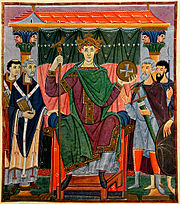Alba (Imperial Regalia)
The Alba of the imperial regalia was loud embroidered inscription in 1181 in Palermo for King William II. Made and later belonged to the coronation of the Holy Roman Emperor .
Today it is in the secular treasury of the Kunsthistorisches Museum in Vienna .
Appearance
The Alba consists of a slightly yellowish taffeta , which in turn is placed on a silk lining of the same color. Two similar motifs are applied to the border, which is richly embroidered with gold. They are lions facing each other on a white background and griffins standing opposite one another on a purple background. There are strips of inscription on the upper and lower edge of the border. One of the stripes contains the Latin inscription:
- † OPERATV (M) FELICI VRBE PANORMI XV ANNO D (OMI) NI W (ILHELMI) D (E) I GR (ATI) A REGIS SICILIE DVCAT (V) S APVLIE ET PRINCIPAT (V) S CAPVE FILII W (ILHELMII REGIS) INDICTIONE XIII ( ref : cited in Fillitz)
The other strip contains an Arabic inscription with the following content:
- (The Alba) is one of those robes that the honored King Wilhelm II ordered to be made, who asks God for his strength, who is supported by his omnipotence and who implores victory for himself from his omnipotence, the Lord of Italy, Lombardy , Calabria and Sicily, the mighty Roman Pope, the defender of the Christian religion. - in the always well-ordered workshop, in the 14th year of the indiction, in the year 1181 of the calendar of our Lord Jesus, the Messiah. ( Lit .: quoted from Fillitz)
The fact that an Arabic inscription praises a Christian ruler, which is surprising at first glance, is due to the fact that the Alba, as can be clearly seen from the inscription, was in the royal workshops, the Nobiles Officinae , the Norman rulers of Sicily in 1181 was made. In these workshops, Arab artists and craftsmen were responsible for the embroidery work, among other things.
The border is lined with six double rows of pearls.
From the original piece, which was made in the Nobiles Officinae, the trims on both sleeves have been preserved in addition to the finishing trims. Due to the depiction of a one-headed eagle, pieces on the lower sleeve borders can be dated to the Hohenstaufen era.
The taffeta of the robe is more recent. Already in 1520 at the coronation of Charles V . in Aachen the old fabric was replaced and the braids were reused. This can be clearly seen from a Nuremberg council resolution, which says:
- The weyssen kaiser Karls dalmatica, who wyl they have been torn apart by age, should be covered with a new knowledge.
However, it cannot be ruled out that the substance is even more recent.
use
This robe cannot be compared to a normal liturgical alba because of its rich decoration and the places where it is attached . This piece of clothing is more like a tunic worn by medieval rulers. For example, that of Otto III. In the picture opposite, the tunic worn is also decorated with cuffs and upper arm braids.
literature
- Hermann Fillitz : The insignia and jewels of the Holy Roman Empire. Schroll, Vienna et al. 1954.
- Wilfried Seipel (Ed.): Nobiles Officinae. The royal court workshops at Palermo during the Normans and Staufers in the 12th and 13th centuries. Skira, Milano 2004, ISBN 3-85497-076-5 .

